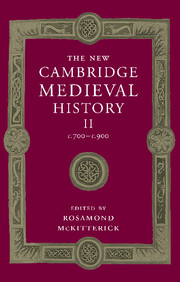Book contents
- Frontmatter
- PART I POLITICAL DEVELOPMENT
- PART II GOVERNMENT AND INSTITUTIONS
- 15 Kingship and royal government
- 16 The aristocracy
- 17 Social and military institutions
- 18 Economic Organisation
- 19 Rural society in Carolingian Europe
- 20 Money and coinage
- PART III CHURCH AND SOCIETY
- PART IV CULTURE AND INTELLECTUAL DEVELOPMENTS
- Conclusion
- Appendix genealogical tables
- List of primary sources
- Bibliography of secondary works arranged by chapter
- Index of manuscripts
- General index
- Frontispiece">
- Plate section
- Map 4 Charlemagne’s Europe and Byzantium, 814
- Map 19 The ecclesiastical provinces of western Europe 700-900
- Map 20 Carolingian schools, scriptoria and literary centres
- Genealogical table X: Wessex
- References
15 - Kingship and royal government
from PART II - GOVERNMENT AND INSTITUTIONS
Published online by Cambridge University Press: 28 March 2008
- Frontmatter
- PART I POLITICAL DEVELOPMENT
- PART II GOVERNMENT AND INSTITUTIONS
- 15 Kingship and royal government
- 16 The aristocracy
- 17 Social and military institutions
- 18 Economic Organisation
- 19 Rural society in Carolingian Europe
- 20 Money and coinage
- PART III CHURCH AND SOCIETY
- PART IV CULTURE AND INTELLECTUAL DEVELOPMENTS
- Conclusion
- Appendix genealogical tables
- List of primary sources
- Bibliography of secondary works arranged by chapter
- Index of manuscripts
- General index
- Frontispiece">
- Plate section
- Map 4 Charlemagne’s Europe and Byzantium, 814
- Map 19 The ecclesiastical provinces of western Europe 700-900
- Map 20 Carolingian schools, scriptoria and literary centres
- Genealogical table X: Wessex
- References
Summary
introduction
with the demise of a political economy based around the Mediterranean, the early eighth century signalled a new beginning in the history of Europe. Henri Pirenne, writing in the early decades of the twentieth century, was the first historian to underline the significance of the break: but his monochrome picture of regression, and ‘an economy of no markets’, is no longer acceptable; nor is his explanation in terms of an external factor, the rise of Islam. Instead, the new economy can be credited with its own dynamic, and the collapse of a system driven by the Roman state seen not as putting an end to exchanges but diversifying them. The new economy had a dual base, in the agrarian wealth of the western European land mass from the Pyrenees to central Germany, and in an exchange system orientated towards the northern seas into which the great rivers of the land mass drained. The vast wealth on which Roman emperors had gorged was a thing of the past: eighth- and ninth-century kings had to make do with smaller slices of diminished cakes. Yet a revised, revived, version of the past seemed still within reach. The resources available to kings, in moveables as well as land, were increasing, and competition, inside and outside realms, produced a new momentum. The reorientation of the west brought into view societies around the northern periphery of the Roman empire which, though remote from its centre, had felt the impact of the empire’s existence: Scandinavians, Irish and Anglo-Saxons would all respond to the creation of a new concentration of power in the west.
- Type
- Chapter
- Information
- The New Cambridge Medieval History , pp. 381 - 430Publisher: Cambridge University PressPrint publication year: 1995
References
- 20
- Cited by

